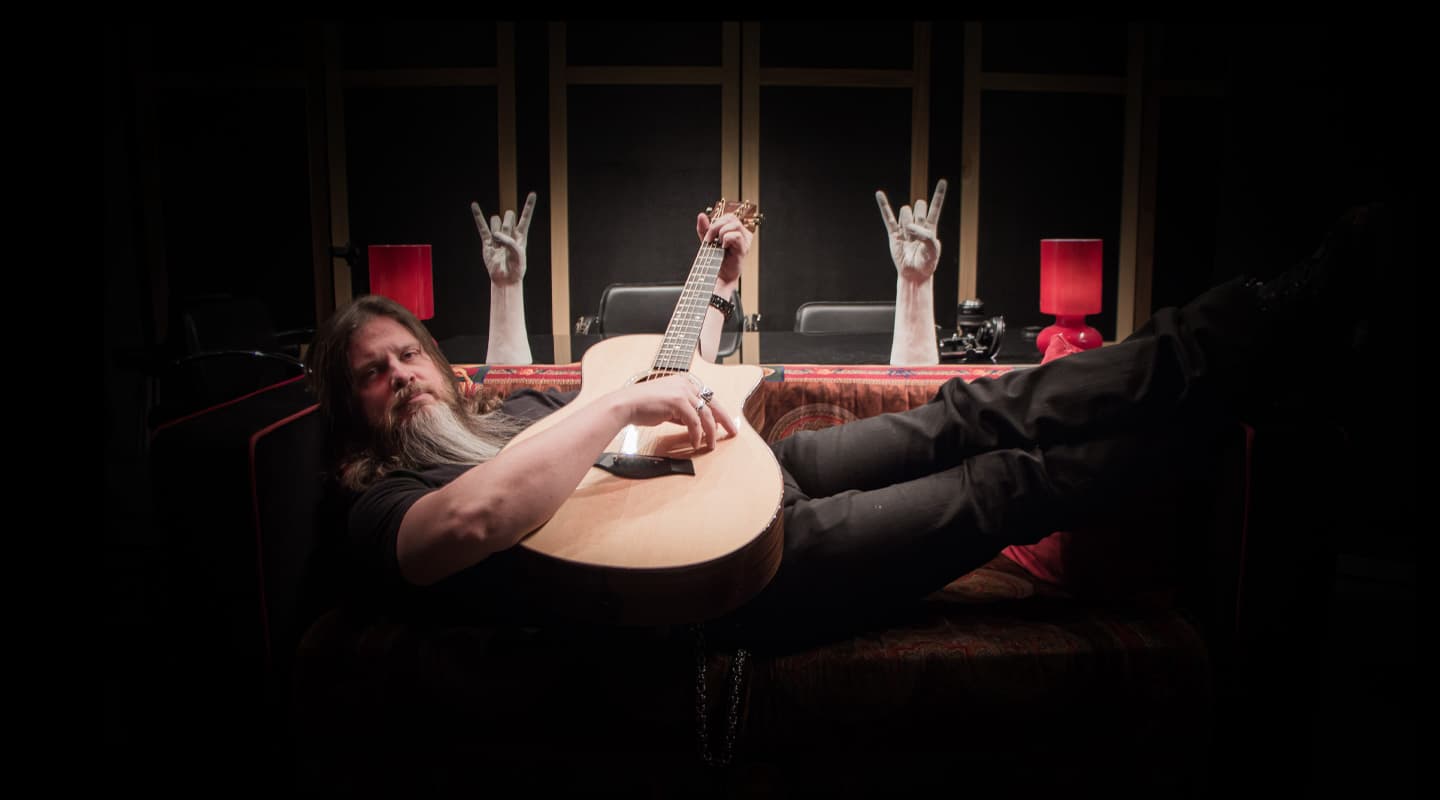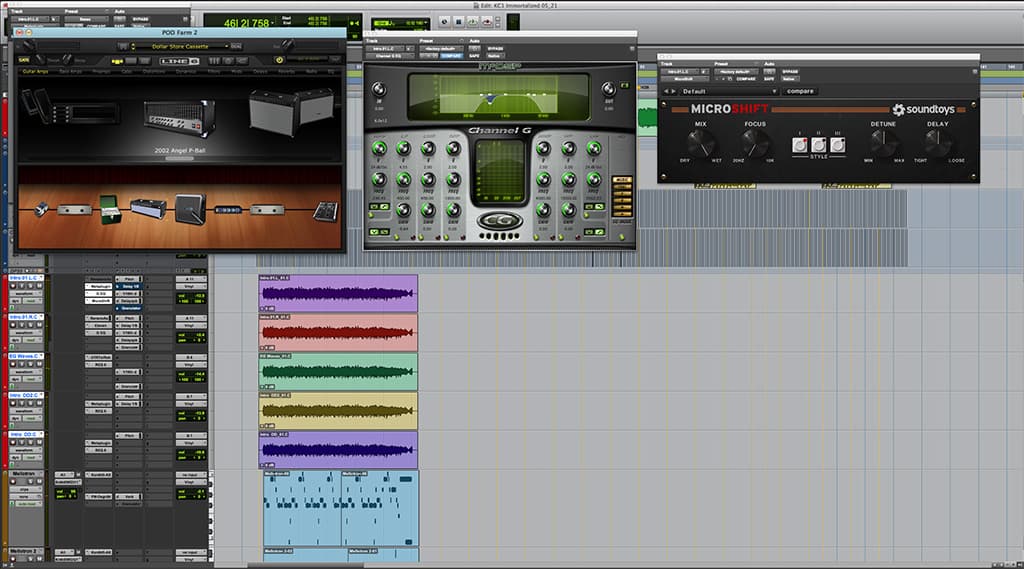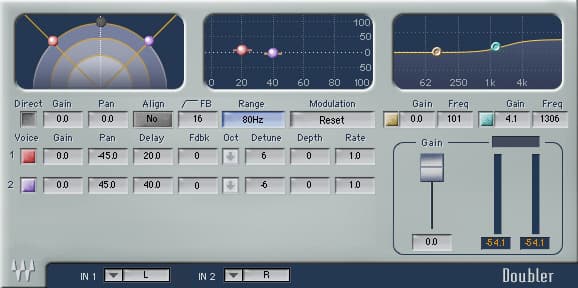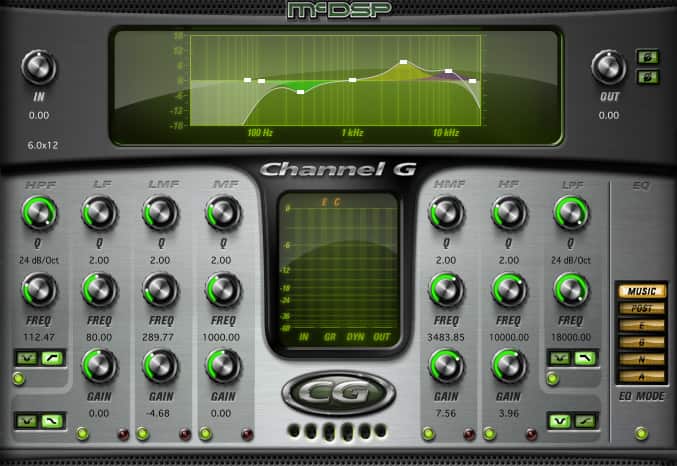
Forging Metal Guitars
Heavy guitars haven’t gone out of style. Churko shows us how it’s done at No.1.
There’s been a worldwide flurry of high-charting heavy metal albums recently. In one week, the top three best-selling albums worldwide were by Bring Me The Horizon, Slayer, and Iron Maiden. This trio of high-flying metal successes came hard on the heels of two other very successful metal albums, Disturbed’s Immortalized and Five Finger Death Punch’s Got Your Six went No.1 and 2 respectively.
Both those bands operate in a similar metal vein, with low-ish screamed vocals; tuned down guitars and basses; busy, hard-hitting drums; and, most of all, monolithic walls of distorted rhythm guitars, at times overlaid by virtuoso guitar solos.
The similarity in sound is not entirely coincidental, as both were engineered, and in varying degrees co-written, mixed and produced by Kevin Churko. From his hideout, Churko shared his expertise on how he went about recording, mixing, and producing the red-hot rhythm and solo guitars on Got Your Six and Immortalized.
4 RHYTHM GUITARS BETTER THAN 1
Churko: “FFDP were the first band I started doing four rhythm guitars with because they always brought in demos with four rhythm guitar tracks. Now I do it with many of the heavy metal bands I produce.
“I have the guitarist play the same part four times: twice with one sound panned left and right, and twice with a slightly different sound, again panned left and right but not quite as wide. This really widens the rhythm guitar and makes it sound huge across the audio spectrum. One sound will be brighter and pointier, the other will be warmer and fatter. I blend these sounds according to what the song needs. Of course, the guitarist has to be exceptionally precise in his playing! It’s all about articulation, and the guitarists play a lot lighter than many people assume. It also takes a lot of work. It’s not like recording a band in a room, live with a few mics. You’re building a wall of sound, brick by brick.”
MIC SETUPS
Churko: “Disturbed brought great demos to my studio recorded at [guitarist] Dan Donagan’s and [singer] David Draiman’s home studios. Dan played all his rhythm guitars through the Kemper Profiling Amp, using one patch that came with the Kemper and one patch I had created at my studio.
“This is my fifth album with FFDP, so I know what they like, and I know what has and has not worked in the past. Zoltan [Bathory] tracked his rhythm guitars at my studio, and I go to Jason [Hook]’s studio to record him. I tend to record guitar cabinets with a Shure SM58 and a Royer 121, sometimes a Sennheiser 421, and then a Vintec 500-series mic pre, and API 550b and Radial Q4 EQs. I DI the guitars as well, just in case we want to reamp them.
“Of course, you first set up the amp and the sound coming from it. In that situation you’re also hearing the ambience in the room, and when you stick mics close up, it sounds very different. I don’t use ambient mics to record rhythm guitars. The rhythm picking styles are very immediate, very tight, and you want to be able to hear all that fast picking.
“Where I place the mics is still a little bit of trial and error, but usually what works best for me is to place them close to the circumference of the cone, slightly facing in with a little bit of angle. That will give me a little bit more attack and articulation. If you put a mic directly on the cone, the sound gets smoother and warmer, but you lose a little bit of articulation. I want to pick up enough of that brightness and articulation without it sounding overly bright.”
EQ ISSUES
Churko: “While recording guitars I’m already thinking of the big picture, going for a good guitar sound, but also making sure it will fit in with the rest of the arrangement. The EQ I use during recording is usually cutting low end and high end over 10k and boosting mid-range. At the recording stage I’m mostly just trying to take away problems, because I will be EQ’ing again later on in Pro Tools.
“I’ll EQ each mic separately and record the two mics on each amp to one track. I could, of course, record each mic to a separate track, but that would double my track count. It just gets messy and running Pro Tools becomes an administration job. Sessions get complicated enough these days. I like to commit to one awesome sound from one amplifier! I don’t really compress guitars during recording, because the guitars already have so much overdrive on them. If you add compression, they’ll just sound smaller.”
DEALING WITH LOW END
Churko: “Recording and mixing bands like Disturbed and FFDP can be quite challenging, because there is so much going on in the low mids and low end. I struggle with that constantly. In the old days everyone was playing in the key of E, and maybe they dropped the low E string to a D, but now the lowest strings of both the guitars and basses are dropped down to A. This can make it hard to even get a tone, because the string is rattling and loose. The drums are also tuned low, and altogether it makes maintaining definition in the rhythm section a big issue.
“Urban music has a big bass, but other than that there’s nothing going on down there, so bass drops will sound awesome. You can’t really hear bass drops in the bands I work with because the sonic space in the low end and low mids is already full. Because the guitars today tend to be in the range where the bass used to be, I have to make them brighter and add more mid-range. Many riffs are played on the bottom two strings and the only way to get definition is through brightness and distortion.”

RECORDING LEAD GUITARS
Churko: “Recording lead guitars is different. The solos from most of the bands I work are very musical, melodic pieces. It needs to sing, with enough sustain for long notes to be hanging for a bar and a half, so the guitarist needs to play with more gain and distortion. At the same time you also want to be able to hear every note when he’s playing fast, so you also want articulation and clarity.
“The solo is the brightest thing in the production, and you don’t want to hide it. It’s all about making the solo sound good. I tend to record the lead guitars with the same mic chain as the rhythm guitars, the main difference in the sound comes from the guitarist turning up the gain or using an additional pedal. But when EQ’ing on the way in, I’ll again cut the low end, but I’ll boost higher frequencies.”
MIX TREATMENTS
Churko: “I mix as I go, all in Pro Tools, using only plug-ins. I’ll get them in their final shape very quickly after recording. I like them to sound the way I want them as early on as I can, because everything is interactive. I may have a great bass sound and a great guitar sound, but the most important thing is that they work with each other. I want to know what I have almost immediately. With a lot of the bands I work with, EQ is both technical — as in being able to hear every note — and artistic, in the sense that I may want it to sound more nasty here or more abrasive there. I may want the listener to be almost angry when listening.
“In general, you EQ things so that everything can be heard. If rhythm guitars are too bright, they are trampling all over the lead vocals in these two bands. Luckily they both have singers with voices that really cut through, but I still often have to cut holes in the guitar frequency spectrum to make space for the vocal. Strangely, you don’t have to make the solo guitar brighter than the rhythm guitars, because it is naturally higher, brighter and louder, so what you tend to do instead is add more body to the lead guitar, which helps it to poke through the mix. Overall, the effects I use on the vocals often also work on the lead guitar. This can include things like doublers and delays.”





















RESPONSES